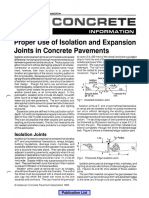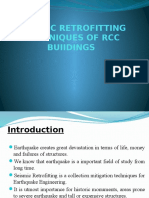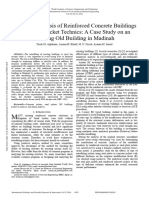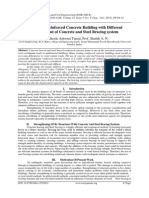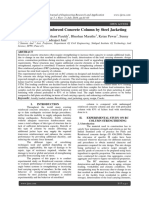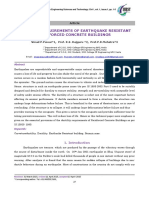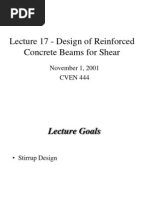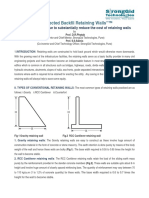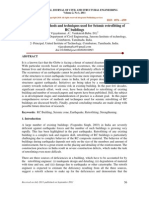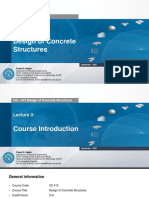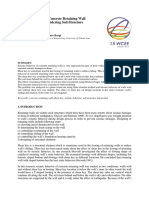Retrofitting of Existing RCC Buildings B PDF
Retrofitting of Existing RCC Buildings B PDF
Uploaded by
mojeebmashalCopyright:
Available Formats
Retrofitting of Existing RCC Buildings B PDF
Retrofitting of Existing RCC Buildings B PDF
Uploaded by
mojeebmashalOriginal Title
Copyright
Available Formats
Share this document
Did you find this document useful?
Is this content inappropriate?
Copyright:
Available Formats
Retrofitting of Existing RCC Buildings B PDF
Retrofitting of Existing RCC Buildings B PDF
Uploaded by
mojeebmashalCopyright:
Available Formats
Retrofitting of Existing RCC Buildings by Method of Jacketing
CHAPTER 1
INTRODUCTION
1.1 SEISMIC STRENGTHENING
Seismic strengthening is defined as the actions taken to upgrade the seismic resistance of an
existing building so that it becomes safe under earthquakes. This can be in the form of providing
seismic bands, eliminating source of weakness or concentrations of large mass and opening in
walls, adding shear walls or strong column points in walls, bracing roofs and floors to be able to
act as horizontal diaphragms adequately connecting roofs to walls and columns and also
connecting between walls and foundations.
1.2 CONCEPT OF RETROFITTING
Retrofitting is technical interventions in structural system of a building that improve the
resistance to earthquake by optimizing the strength, ductility and earthquake loads. Strength of
the building is generated from the structural dimensions, materials, shape and number of
structural elements. Ductility of the building is generated from good detailing, materials used,
degree of seismic resistant etc. Earthquake load is generated from the site seismicity, mass of the
structures, important of buildings, degree of seismic resistant etc.
Due to variety of structural condition of building, it is hard to develop typical rules for
retrofitting. Each building has different approaches depending upon the structural deficiencies.
Hence engineers are needed to prepare and design the retrofitting approaches. In the design of
retrofitting approach, the engineers must comply with the building codes. The results generated
by adopting retrofitting techniques must fulfill the minimum requirements on the building codes
such as deformation, detailing strength etc.
1.3 CAUSES OF FAILURE
Damage of buildings was caused by a combination of affects:
Old decaying buildings predating modern construction practices.
New buildings not being designed to Indian Earthquake codes.
MLMCE 1 Civil Engineering
Retrofitting of Existing RCC Buildings by Method of Jacketing
CHAPTER 2
STRENGTHENING OF RCC STRUCTURES
2.1 INTRODUCTION
Structure repair and rehabilitating is a process whereby an existing structure is enhanced to
increase the probability that the structure will survive for a long period of time and also against
earthquake forces. This can be accomplished through the addition of new structural elements, the
strengthening of existing structural elements and/or the addition of base isolators. Deterioration
of concrete and corrosion of embedded reinforcement structure might make the R.C.C structure
structurally deficient. Corrosion can be controlled to some extent by fixing of chloride or
protective coating
Before any repair work is put in hand, the cause of damage must be identified as clearly
as possible. This principle may seem self-evident but it is surprising how often it is disregarded,
with the result that further repairs have to be carried out within a short time. Sometimes the cause
is obvious as, for example, in many cases of accidental damage but, more often than not, careful
investigation is required. The next step must be to consider the objective of the repair, which will
generally be to restore or enhance one or more of the following:
Durability
Structural strength
Function
Appearance.
Of these four requirements, restoration of durability is by far the most common in repair
work. One must also consider whether the repair is to be permanent or temporary. Only after
deciding on the most likely cause of damage, whether it is likely to occur, and the purpose of the
work, should the method of repair be chosen.
2.2 CONVENTIONAL STRENGTHENING METHODS
These are the conventional strengthening methods adopted to rehabilitate RCC
Grouting process
Guniting Process
MLMCE 2 Civil Engineering
Retrofitting of Existing RCC Buildings by Method of Jacketing
Application of Epoxy Resins
Section Enlargement or Jacketing
Post Tensioning
Bonded Steel Plates
Carbon Fiber Reinforced Plastics(CFRP) for Repair & Strengthening
2.2.1 Grouting
It is the process of placing a material into cavities in concrete for the purpose of increasing the
load bearing capacity of the structure, grouting restores the monolithic nature of the structure.
Primary grouting materials and their common uses are:
Table 2.1 Primary grouting materials
CHEMICAL CEMENTITIOUS
Control Seepage Mass Placement
Shut-off Seepage Structural (high strength)
EPOXY POLYURETHANES
Seal Cracks Building Envelope Insulation
Acidic Environments Acoustical Sealant
POLYSTERS SILICONES
Bolt Anchoring Smoke Seals
MLMCE 3 Civil Engineering
Retrofitting of Existing RCC Buildings by Method of Jacketing
2.2.2 Guniting Process
Guniting is an effective method, which has been extensively used in the rehabilitation of
structurally distressed RC members. There have been cases of heavy rusting of the mesh in the
form of powder or in the form of sheets coming out. The Guniting process suffers from
drawbacks like dust and noise nuisance.
2.2.3 Application of Epoxy Resins
In this method of strengthening, an epoxy adhesive normally consisting of two components a
resin and a hardener is used to bond steel plates to overstressed regions of RC members.
Normally, the steel plates are located tension zone of concrete to enhance the flexural capacity.
The plates can also be placed at the compression and shear regions to enhance the axial and shear
capacities of the RC structural elements
2.2.4 Section Enlargement or Jacketing
In this method the entire height of the column section is increased and a cage of additional main
reinforcement bars with shear stirrups is provided right from the foundation as per the
requirement of additional load, etc. However, there are many instances where the column section
is increased with additional reinforcement bars only on one face, and that too starting from the
floor slab level of a particular floor and only up to the height of deterioration of the column .The
enlargement should be bonded to the existing concrete to produce a monolithic member .Cement
mortar is used for these enlargements.
The section enlargement method is relatively easy to construct and economically
effective. The disadvantages of this method are a high risk of corrosion of embedded reinforcing
steel and concrete deterioration. These problems are associated with relative dimensional
incompatibility between existing and new concrete. The restrained volume changes of new
material are inducing tensile stresses that may lead to cracking and delaminating when the
induced tensile stresses are greater than tensile strain capacity of tile new material
The way to make this strengthening technique effective in the future is to use materials
with higher tensile strain capacity, with low shrinkage properties
MLMCE 4 Civil Engineering
Retrofitting of Existing RCC Buildings by Method of Jacketing
Figure 2.1 Additional Reinforcement & Micro concreting
2.2.5 Post Tensioning
External prestressing is now widely developed for concrete strengthening in the United States,
Japan &Switzerland. External prestressing techniques have been employed with great success to
correct excessive and undesirable deflections in existing structure. They have also been used to
strengthen existing concrete structures to carry additional loads
It can be used on tile inside of box girders or the outside of I girders to increase the
capacity of existing bridges and to provide improved resistance to fatigue and cracking.
2.2.6 Bonded Steel Plates
In this method of strengthening steel plates or other steel elements are glued to the concrete
surface by a two component epoxy adhesive creating a three-phase concrete glue steel composite
system. The wide acceptance and at the same time attractiveness is due to negligible changes to
overall dimensions of the structure and minimum disruption to its use. At the same time,
adequate design, specification and execution of the job will ensure the necessary composite
action for the designed loading range. It was demonstrated that steel plates bonded to the tension
MLMCE 5 Civil Engineering
Retrofitting of Existing RCC Buildings by Method of Jacketing
face of the concrete beams can lead to increase in flexural capacity, along with increase in
flexural stiffness and associated decreases in deflection and cracking.
2.2.7 Carbon Fiber Reinforced Plastics (CFRP) for Repair & Strengthening
CFRP has high strength, lightweight, excellent strength to weight ratio, resistant to chemicals
(acids and bases), good fatigue strength, and nonmagnetic, non-corrosive and nonconductive
properties. As with any composite system, bond of the strengthening plate the existing concrete
is very critical. Therefore, the surface preparation of both phases of tile system, concrete and
CFRP plates is very important .The plates should be ground on tile bonding side, immediately
before bonding, the surface should be cleaned with acetone. After mixing the epoxy glue
component should be placed oil tile plate without delay, after assembling the plate in the design
position, a slight pressure is applied to squeeze out excessive adhesive
MLMCE 6 Civil Engineering
Retrofitting of Existing RCC Buildings by Method of Jacketing
CHAPTER 3
JACKETING
3.1 INTRODUCTION
Jacketing is one of the most frequently & popularly used techniques to strengthen reinforced
concrete (RC) columns. With this method, axial strength, bending strength, and stiffness of the
original column are increased. It is well known that the success of this procedure is dependent on
the monolithic behavior of the composite element. To achieve this purpose, the treatment of the
interface must be carefully chosen. The common practice consists of increasing the roughness of
the interface surface and applying a bonding agent, normally an epoxy resin. Steel connectors are
also occasionally applied. These steps involve specialized workmanship, time, and cost.
Concerning the added concrete mixture and due to the reduced thickness of the jacket, the option
is usually a grout with characteristics of self-compacting concrete (SCC) and high strength
concrete (HSC).
The most common types of jackets are steel jacket, reinforced concrete jacket, fiber
reinforced polymer composite jacket, jacket with high tension materials like carbon fiber, glass
fiber etc. The main purposes of jacketing are:
1. To increase concrete confinement by transverse fiber reinforcement, especially for
circular cross-sectional columns
2. To increase shear strength by transverse fiber reinforcement
3. To increase flexural strength by longitudinal fiber reinforcement provided.
3.2 TECHNICAL CONSIDERATIONS
The main objective of jacketing is to increase the seismic capacity of the moment resisting
framed structures. In almost every case, the columns as well .as beams of the existing structure
have been jacketed. In comparison to the jacketing of reinforced concrete columns, jacketing of
reinforced concrete beams with slabs is difficult yielding good confinement because slab causes
hindrance in the jacket. In structures with waffle slab, the increase in stiffness obtained by
jacketing columns and some of the ribs, have improved the efficiency of structures. In some
cases, foundation grids are strengthened and stiffened by jacketing their beams. An increase in
strength, stiffness and ductility or a combination of them can be obtained. Jacketing serves to
MLMCE 7 Civil Engineering
Retrofitting of Existing RCC Buildings by Method of Jacketing
improve the lateral strength and ductility by confinement of compression concrete. It should be
noted that retrofitting of a few members with jacketing or some other enclosing techniques
might not be effective enough to improve the overall behavior of the structure, if the remaining
members are not ductile.
3.3 JACKETING OF COLUMNS
Jacketing of columns consists of added concrete with longitudinal and transverse reinforcement
around the existing columns. This type of strengthening improves the axial and shear strength of
columns while the flexural strength of column and strength of the beam-column joints remain the
same. It is also observed that the jacketing of columns is not successful for improving the
ductility. A major advantage of column jacketing is that it improves the lateral load capacity of
the building in a reasonably uniform and distributed way and hence avoiding the concentration of
stiffness as in the case of shear walls. This is how major strengthening of foundations may be
avoided. In addition the original function of the building can be maintained, as there are no major
changes in the original geometry of the building with this technique. The jacketing of columns is
generally carried out by two methods:
(i) Reinforced concrete jacketing
(ii) Steel jacketing.
3.3.1 Reinforced Concrete Jacketing
Reinforced concrete jacketing can be employed as a repair or strengthening scheme. Damaged
regions of the existing members should be repaired prior to their jacketing. There are two main
purposes of jacketing of columns:
Increase in the shear capacity of columns in order to accomplish a strong column-weak
beam design
To improve the column's flexural strength by the longitudinal steel of the jacket made
continuous through the slab system are anchored with the foundation. It is achieved by
passing the new longitudinal reinforcement through holes drilled in the slab and by
placing new concrete in the beam column joints as illustrated in figure 3.1. Rehabilitated
sections are designed in this way so that the flexural strength of columns should be
greater than that of the beams. Transverse steel above and below the joint has been
provided with details, which consists of two L-shaped ties that overlap diagonally in
MLMCE 8 Civil Engineering
Retrofitting of Existing RCC Buildings by Method of Jacketing
opposite corners. The longitudinal reinforcement usually is concentrated in the column
corners because of the existence of the beams where bar bundles have been used as
shown in figure 3.1
Figure 3.1 Construction Techniques for Column Jacketing
MLMCE 9 Civil Engineering
Retrofitting of Existing RCC Buildings by Method of Jacketing
Table 3.1 Details of Reinforced Concrete Jacketing
Match with the concrete of the existing structure.
Properties of jackets
Compressive strength greater than that of the existing structures
by 5 N/mm2or at least equal to that of the existing structure.
10 cm for concrete cast-in-place and 4 cm for shotcrete.
If possible, four-sided jacket should be used.
A monolithic behavior of the composite column should be
Minimum width of
assured.
jacket
Narrow gap should be provided to prevent any possible increase
in flexural capacity.
Designed and spaced as per earthquake design practice.
Minimum area of
Minimum bar diameter used for ties is not less than 10 mm or 1/3
transverse
of the diameter of the biggest longitudinal bar.
reinforcement
The ties should have 135-degree hooks with 10bar diameter
anchorage
3Afy, where, A is the area of contact in cm2 and fy is in kg/cm2
Spacing should not exceed six times of the width of the new
Minimum area of
longitudinal elements (the jacket in the case) up to the limit of 60 cm.
reinforcement Percentage of steel in the jacket with respect to the jacket area
should be limited between 0.015and 0.04.
At least, 12 mm bar should be used at every corner for a four
sided jacket
Provide adequate shear transfer mechanism to assured monolithic
behavior.
A relative movement between both concrete interfaces (between
Shear stress in the the jacket and the existing element) should be prevented.
interface Chipping the concrete cover of the original member and
roughening its surface may improve the bond between the old and
the new concrete.
For four-sided jacket, the ties should be used to confine and for
MLMCE 10 Civil Engineering
Retrofitting of Existing RCC Buildings by Method of Jacketing
shear reinforcement to the composite element
Connectors should be anchored in both the concrete such that it
may develop at least
80% of their yielding stress.
Distributed uniformly around the interface, avoiding concentration
Connectors in specific locations.
It is better to use reinforced bars (rebar) anchored with epoxy
resins of grouts.
3.3.2 Steel Jacketing
Local strengthening of columns has been frequently accomplished by jacketing with steel plates.
A general feature of steel jacketing is mentioned in Table 3.2
Figure 3.2 Construction Techniques for Steel Jacketing
MLMCE 11 Civil Engineering
Retrofitting of Existing RCC Buildings by Method of Jacketing
Table 3.2 Details Of Steel Jacketing.
Steel plate thickness At least 6 mm
1.2 to 1.5 times splice length in case of flexural
Height of jacket columns.
Full height of column in case of shear columns
Rectangular jacketing, prefabricated two L-shaped
panels The use of rectangular jackets has proved to
be successful in case of small size columns upto 36
inch width that have been successfully retrofitted
Shape of jackets with %" thick steel jackets combined with adhesive
anchor bolt, but has been less successful on larger
rectangular columns. On larger columns, rectangular
jackets appear to be incapable to provide adequate
confinement
Welded throughout the height of jacket, size of weld
38 mm (1.5 inch), steel jacket may be terminated
Free ends of jackets bottom above the top of footing to avoid any possible
clearance. bearing of the steel jacket against the footing, to
avoid local damage to the jacket and/or an
undesirable or unintended increase in flexural
capacity.
25 mm fill with cementations grout.
25 mm in diameter and 300 mm long embedded in
Gap between steel jacket and
200 mm into concrete column.
concrete column Size of anchor
Bolts were installed through pre-drilled holes on the
Number of anchor bolts
steel jacket using an epoxy adhesive.
Two anchor bolts are intended to stiffen the steel
jacket and improve confinement of the splice.
3.4 BEAM JACKETING
Jacketing of beams is recommended for several purposes as it gives continuity to the columns
and increases the strength and stiffness of the structure. While jacketing a beam, its flexural
resistance must be carefully computed to avoid the creation of a strong beam-weak column
system. In the retrofitted structure, there is a strong possibility of change of mode of failure and
redistribution of forces as a result of jacketing of column, which may consequently causes beam
MLMCE 12 Civil Engineering
Retrofitting of Existing RCC Buildings by Method of Jacketing
hinging. The location of the beam critical section and the participation of the existing
reinforcement should be taken into consideration. Jacketing of beam may be carried out under
different ways, the most common are one-sided jackets or 3- and 4-sided jackets. At several
occasions, the slab has been perforated to allow the ties to go through and to enable the casting
of concrete. The beam should be jacketed through its whole length. The reinforcement has also
been added to increase beam flexural capacity moderately and to produce high joint shear
stresses. Top bars crossing the orthogonal beams are put through holes and the bottom bars have
been placed under the soffit of the existing beams, at each side of the existing column. Beam
transverse steel consists of sets of U-shaped ties fixed to the top jacket bars and of inverted U-
shaped ties placed through perforations in the slab, closely spaced ties have been placed near the
joint region where beam hinging is expected to occur (figure no. 3.3). The main features of
reinforcement details of beam jacketing are given in table 3.3 although those guidelines can give
a rational basis for practical design; research still needs to address critical aspects in the behavior
of jacketed elements. The change in behavior in jacketed elements, whose shear span/depth
ratios are significantly reduced, due to their jacketing, needs to be clarified.
Fig 3.3 Construction Technique for Beam Jacketing
MLMCE 13 Civil Engineering
Retrofitting of Existing RCC Buildings by Method of Jacketing
Table 3.3 Reinforcement of beam jacketing.
8 cm if concrete cast in place or 4 cm for
shotcrete
Minimum width for jacket
Percentage of steel on the jacket should be
Longitudinal reinforcement
limited to 50 of the total area of the composite
section
Ignore the effect of existing shear
reinforcement
New reinforcement should have 135 hooks and
at each corner of the tie there must be at least
one longitudinal bar.
Shear reinforcement
The bar used for the tie should have at least 8
mm diameter
Multiple piece ties can be used, as discussed
before for columns
Span/depth ratio
Depth of jacketed beam Storey height
Ductile behavior
MLMCE 14 Civil Engineering
Retrofitting of Existing RCC Buildings by Method of Jacketing
CHAPTER 4
RETROFITTING OF HEALTH BUILDING AT NASIK A CASE STUDY
4.1 GENERAL
In order to overcome the future disorders that may have occurred due to unwanted and no
predicted disasters it was decided to strengthen the existing Health building located in the central
part of Nasik city. This building was proposed in 1984 and accordingly was designed for B + G
+ 4 stories. The building during its life span at the end in 2008 found completely deteriorated and
was not capable to sustain further loads and was predicted that it may fail due to the following
reasons.
a) Higher ground water table in the locality.
b) Faulty workmanship during the stage of execution at initial stage.
c) The columns were not centered properly in their position.
d) Improper methods of compaction to the concrete.
e) Insufficient cover to the steel reinforcement.
In addition to this it may also have caused failure due to the non predicted disasters as was
caused too many buildings in the past which are listed in the next bit.
4.2 CAUSES OF FAILURE AND DAMAGES TO THE BUILDING IN PAST FEW
EARTHQUAKES
Following were the main causes of failure and damages to the buildings in Gujarat &
Maharashtra; causes to buildings same in rest part India.
Damages to buildings were caused by a combination of affects:
Old decaying buildings predating modern construction practices
New Buildings not being designed to Indian earthquake codes
Lack of knowledge, understanding or training in the use of these codes by local engineers
Unawareness that Gujarat and some part of Maharashtra is a highly seismic region
Buildings erected without owners seeking proper engineering advice
MLMCE 15 Civil Engineering
Retrofitting of Existing RCC Buildings by Method of Jacketing
Improper detailing of masonry and reinforced structures
Poor materials, construction and workmanship used, particularly in commercial buildings
Alterations and extensions being carried out without proper regard for effects on structure
during an earthquake.
Buildings having poor quality foundations or foundations built on poor soils.
Little or no regularity authority administering or policing the codes.
Its necessary to every civil engineer to have knowledge of proper repairs and strengthening of
earthquake damaged buildings. Indian standards exist but are not used by local engineers or
builders in urban or rural areas, mainly due to lack of knowledge and training. As a result, many
of the owner-occupiers have unknowingly been carrying out bad repairs in Gujarat. Many
buildings have been severely weakened, and the experts are concerned to that there could be
another disaster in waiting from a future earthquake. Good repairs, using well-recognized
seismic standards may reduce this vulnerability.
This project aims in simple terms to explain to the engineers why earthquakes happen in
India, which regions are seismically active, how buildings respond in an earthquake; and how to
safely carry out good repair and strengthening techniques to damaged and low strength buildings.
Fig.4.1 Some damages those were occurred after earth quake at Gujarat in non engineered R.C.C building
construction
The inset shows large deformations were concentrated at column heads, which caused many soft
storey failures, as per picture. Buildings if designed with uniform deflections of insert would
have survived without collapse.
MLMCE 16 Civil Engineering
Retrofitting of Existing RCC Buildings by Method of Jacketing
4.3 RETROFITTING OF R.C.C BUILDING BY METHOD OF JACKETING
As its shown in above part of chapter no five, that Nasik and some part of Maharashtra is along
the border part of Gujarat, Gujarat has suffered from severe earth quake in last two decades,
nobody knows which would be the next time of future earth quake & its intensity. Like Gujarat
many constructions in Maharashtra and at Nasik are found as non engineered unsafe & quality
compromised constructions, this would be future risk for coming days. So it is necessary to carry
out the non destructive tests of all construction in Nasik and rest part of India, to save valuable
lives and properties, nowadays many advance retrofitting techniques are available in the world,
those can be used to repair & strengthen the unsafe and damaged buildings. Here the paper has
its focus on a Health building which is under execution (for re modification and strengthening of
existing structure).
4.4 HISTORY OF HEALTH BUILDING
A group proposed to start a hospital in Nasik in 1984. And as per the decision the detail plan
& the structural details for the same were prepared. It was proposed to construct a Basement + G
+ 4 storey structure and the designs were prepared so. The site for the hospital was near Dwarka
circle. Nasik: 11. Though it was planned to construct 6 storey in all, only 2 storey ( i. e.
Basement + G) structure was constructed in actual when structural details were for 6 storey. The
built up area for basement is 1236 sq.mt. And that of the ground floor is 1178 sq. mt. This group
had a smooth functioning up to 2004. Then in 2005 the administration of the hospital was
changed. New administrative body utilized the same infrastructure up to 2008. Then in 2009
was decided to extend the building as per the initial plan and structural details and for the same
had the structural audit in that respect. From the audit it was found that all the defects were at the
execution stage. The faults that were concluded were as below.
a) The high ground water table in the region.
b) Eccentricity of all the columns was a serious problem observed.
c) Improper techniques that were followed during mixing, placing & compacting the concrete.
d) There were many loose pockets found in the concrete.
e) Sufficient concrete cover at different stages to the steel reinforcement was not maintained.
f) The terrace slabs are provided with unwanted thickness of IPS flooring at the top.
MLMCE 17 Civil Engineering
Retrofitting of Existing RCC Buildings by Method of Jacketing
From the NDT test results it was suggested that the management should demolish the
entire existing structure instead of extending it and go for complete new structure. The
management refused to do so and asked to suggest such a measure so that the existing
infrastructure at least can withstand and be utilized for 5 7 years more. As the final conclusion
and the requirement of the management it was decided to go for Retrofitting of the Structure.
4.5 THE STEPS THAT WERE SUGGESTED AND ARE ADOPTED
The entire flooring at the basement to be removed & to be provided again with a raft
below it. To overcome the uplift pressure that could be generated due to the higher
ground water table it was suggested to provide a raft below the basement floor.
All the columns should be jacketed. In the existing structure it was found that the
columns were not centered properly in their position, due to which they were
subjected to unwanted eccentric loads. Also the concrete in columns, beams, slabs
was not compacted properly which created loose pockets & honey combs in the
components. Suitable cover for the reinforcement was not maintained.
To overcome the above difficulties it was decided to jacket all the columns such that the
eccentricity of loading will be reduced, the loose pockets of concrete will be capable to sustain
the load to which the column is subjected & all the steel get the required concrete covering.
The loose pockets in the concrete in the beams are also removed and recasted in M25
grade.
The unwanted heavy loading of water proofing (IPS flooring) damaged the slab to
greater extent.
Therefore, five slabs are entirely opened, strengthened with additional reinforcement and
are casted with 150 mm thick M25 grade concrete layer.
The estimated cost of retrofitting the existing structure is 4.5 crore. To meet the further
requirement of infrastructure the management now is constructing additional new building
with G + 2 storey, instead of razing the existing building.
MLMCE 18 Civil Engineering
Retrofitting of Existing RCC Buildings by Method of Jacketing
Fig 4.2 Column jacketing at basement stage
Fig 4.3 Beam column junction strengthening in basement
MLMCE 19 Civil Engineering
Retrofitting of Existing RCC Buildings by Method of Jacketing
4.4 finished Column after jacketing work
Fig 4.5 Rusting condition of existing slabs reinforcement
MLMCE 20 Civil Engineering
Retrofitting of Existing RCC Buildings by Method of Jacketing
Fig 4.6 Replaced slab reinforcement for existing rusted steel reinforcement
Fig 4.7 Application of chemical admixtures at the joint of new and old concrete
MLMCE 21 Civil Engineering
Retrofitting of Existing RCC Buildings by Method of Jacketing
Fig 4.8 Compaction of concrete by needle vibrator and placement of cover blocks
Fig 4.9 Finished slabs - ready to cure
MLMCE 22 Civil Engineering
Retrofitting of Existing RCC Buildings by Method of Jacketing
As discussed above all works those were carried out on strengthening of the Health building at
Nasik, will definitely increases the strength of existing building, this practice would be necessary
for many buildings at Nasik and rest of India, it will save the many lives, when any natural
disasters will occur.
MLMCE 23 Civil Engineering
Retrofitting of Existing RCC Buildings by Method of Jacketing
CHAPTER 5
CONCLUSIONS
The analysis of results of this experimental study led to the following statements:
1) All models behaved monolithically independent of the adopted interface
preparation method,
2) Whether the strengthening operation was carried out with or without an axial load
applied had no significant influence for the adopted conditions;
3) The resistance of the strengthened models was considerably higher than that of
the original column and slightly higher than that of the monolithic model;
4) The stiffness of the strengthened models was considerably higher than that of the
original column;
5) The transverse reinforcement strain of the original column was significantly
higher in the no strengthened model than in the strengthened models, although the
horizontal force applied in the first case was less than half the corresponding
value in the other cases; and
6) The contribution of the adherent jacket to the horizontal force resistance varied
between 86 and 90%.
Thus it was also confirmed that RC jacketing is a very effective strengthening technique, leading
to values of resistance and stiffness of the strengthened column considerably higher than those of
the original column.
JOURNAL
MLMCE 24 Civil Engineering
Retrofitting of Existing RCC Buildings by Method of Jacketing
REFERENCE
1. Bhavar Dadasaheb, Retrofitting of existing RCC buildings by method of jacketing
IJRMEET-Volume 1,Issue 5 (June 2013)
2. E S Julio, Structural rehabilitation of columns with reinforced concrete jacketing Prog
Structural Engineering Mater, Volume 5 (2010)
3. Eduardo N B, Reinforced concrete jacketing interface influence on monolithic loading
response ACI Structural Journal (2007)
4. Gnanasekaran Kaliyaperumal, Seismic retrofit of columns in buildings for flexure using
concrete jacket SET Journal of Earthquake Technology, Volume 46 (June 2009)
5. Hamidreza Nasersaeed, Evaluation of behavior and seismic retrofitting of RC structures
by concrete jacket Asian Journal Of Applied Sciences, Volume 4(2011)
6. Pravin B Waghmare, Materials and jacketing techniques for retrofitting of structures
IJAERS(2012)
7. Ramirez Ortiz J L & Barcena Diaz J M, Strengthening effectiveness of low quality
reinforced concrete columns strengthened by two different procedures Informes De La
Construction, Volume 272(July 2008)
MLMCE 25 Civil Engineering
You might also like
- Bison Hollow Core FloorsDocument16 pagesBison Hollow Core FloorsJohn WoodsNo ratings yet
- Design of Concrete Slab Elements in Biaxial Bending: October 2010Document21 pagesDesign of Concrete Slab Elements in Biaxial Bending: October 2010Myron OikonomakisNo ratings yet
- Joints in Pavements PDFDocument2 pagesJoints in Pavements PDFmojeebmashalNo ratings yet
- DDM04 S310 16 SupplementDocument4 pagesDDM04 S310 16 SupplementmojeebmashalNo ratings yet
- Seismic Retrofit For Reinforced Concrete Structures 11947 ThZ0z8WDocument24 pagesSeismic Retrofit For Reinforced Concrete Structures 11947 ThZ0z8WPT shamhoonNo ratings yet
- RetrofittingDocument26 pagesRetrofittingSwaraj RathodNo ratings yet
- Retrofitting of Reinforced Concrete BuildingsDocument3 pagesRetrofitting of Reinforced Concrete BuildingsCharan Reddy100% (1)
- Seismic Retrofitting Techniques of RCC BuiidingsDocument29 pagesSeismic Retrofitting Techniques of RCC BuiidingschbaskerNo ratings yet
- Pushover Analysis of Reinforced Concrete Buildings Using Full Jacket Technics A Case Study On An Existing Old Building in MadinahDocument10 pagesPushover Analysis of Reinforced Concrete Buildings Using Full Jacket Technics A Case Study On An Existing Old Building in Madinahsasan babaeiNo ratings yet
- Lecture - 37: Case Studies On Retrofitting and RehabilitationDocument38 pagesLecture - 37: Case Studies On Retrofitting and Rehabilitationu10ce073No ratings yet
- Seismic Retrofitting of Mani Mandir Complex at Morbi, Gujarat, IndiaDocument15 pagesSeismic Retrofitting of Mani Mandir Complex at Morbi, Gujarat, IndiaShubhaNo ratings yet
- Libro de Reforzamiento HORMIGON ARMADO 2022-10Document25 pagesLibro de Reforzamiento HORMIGON ARMADO 2022-10David Magne MamaniNo ratings yet
- Analysis of Reinforced Concrete Building With Different Arrangement of Concrete and Steel Bracing SystemDocument5 pagesAnalysis of Reinforced Concrete Building With Different Arrangement of Concrete and Steel Bracing SystemIOSRjournal100% (1)
- Retrofitting of Reinforced Concrete Column by Steel JacketingDocument5 pagesRetrofitting of Reinforced Concrete Column by Steel JacketingAhsan RafiqNo ratings yet
- Analysis of G+20 RC Building in Different Zones Using Etabs: Narla Mohan, A.Mounika VardhanDocument14 pagesAnalysis of G+20 RC Building in Different Zones Using Etabs: Narla Mohan, A.Mounika VardhanRohan ChauguleNo ratings yet
- Seismic Assessment and Retrofitting of Existing BuildingDocument52 pagesSeismic Assessment and Retrofitting of Existing BuildingInamNo ratings yet
- Review Paper On Effective Methods For The Retrofitting of Reinforced Concrete StructuresDocument6 pagesReview Paper On Effective Methods For The Retrofitting of Reinforced Concrete StructuresIJRASETPublicationsNo ratings yet
- Retrofitting and Strengthening of Structures: Dr.P.Rathish Kumar Department of Civil Engineering NIT WarangalDocument64 pagesRetrofitting and Strengthening of Structures: Dr.P.Rathish Kumar Department of Civil Engineering NIT Warangalabcd efgh100% (1)
- RRSDocument21 pagesRRSHardik ChaudhariNo ratings yet
- Sismo en RomaniaDocument63 pagesSismo en RomaniaJose García HerreroNo ratings yet
- Juan Gomez - 5426138 - Height Increase of Concrete Structures Buildings Through Retrofitting MethodsDocument8 pagesJuan Gomez - 5426138 - Height Increase of Concrete Structures Buildings Through Retrofitting Methodsjuancamilo gomezNo ratings yet
- Ductility Requirements of Earthquake Res PDFDocument6 pagesDuctility Requirements of Earthquake Res PDFAbdullah SimpsonNo ratings yet
- Seismic Behavior of Beam Column Joints in Reinforced Concrete Moment Resisting Frames 2Document36 pagesSeismic Behavior of Beam Column Joints in Reinforced Concrete Moment Resisting Frames 2m7j7a7No ratings yet
- Shear WallDocument22 pagesShear WallWanda Beasley100% (1)
- Design of Steel Structures With Worked EDocument6 pagesDesign of Steel Structures With Worked EKariim DiíbNo ratings yet
- Seismic Retrofit Schemes For RC StructuresDocument15 pagesSeismic Retrofit Schemes For RC StructuresRodolfo Chua, Jr.No ratings yet
- Sikaplan WT 4220 Sheet Membrane Potable Water Reservoirs EngDocument20 pagesSikaplan WT 4220 Sheet Membrane Potable Water Reservoirs EngMartin UrbietaNo ratings yet
- Static Linear and Non Linear (Pushover) Analysis of RC Building On Sloping Grounds On Medium Soils in Different ZonesDocument10 pagesStatic Linear and Non Linear (Pushover) Analysis of RC Building On Sloping Grounds On Medium Soils in Different ZonesIAEME PublicationNo ratings yet
- Professional Review Guidance Re PDFDocument23 pagesProfessional Review Guidance Re PDFrahulgehlot2008No ratings yet
- Lecture 17 - Design of Reinforced Concrete Beams For Shear: November 1, 2001 CVEN 444Document35 pagesLecture 17 - Design of Reinforced Concrete Beams For Shear: November 1, 2001 CVEN 444Ram RamisettiNo ratings yet
- 8.4 Seismic Retrofitting PracticesDocument37 pages8.4 Seismic Retrofitting Practicessuman subediNo ratings yet
- To Study Analysis and Design of Multi-Storey Building Using STAAD-pro. and Comparing With Manual CalculationsDocument10 pagesTo Study Analysis and Design of Multi-Storey Building Using STAAD-pro. and Comparing With Manual Calculationssarfraj ansariNo ratings yet
- CFD Is 456 2000Document85 pagesCFD Is 456 2000Angel VargasNo ratings yet
- 10 Ribbed Slab DesignDocument32 pages10 Ribbed Slab DesignSarah HaiderNo ratings yet
- Engineering Structures: Phaiboon PanyakapoDocument14 pagesEngineering Structures: Phaiboon PanyakapoАвирмэдийн ГэрэлболдNo ratings yet
- IStructE Sustainability Articles August - December 2020Document99 pagesIStructE Sustainability Articles August - December 2020zaidiamna9No ratings yet
- Retrofitting of StructuresDocument28 pagesRetrofitting of StructuresKapil DhabuNo ratings yet
- A Final Report OnDocument44 pagesA Final Report Onpawan bhattaraiNo ratings yet
- Retrofitting of Reinforced Concrete BuildingsDocument36 pagesRetrofitting of Reinforced Concrete BuildingsKalmesh U PeerannavarNo ratings yet
- Composite StructuresDocument12 pagesComposite StructuresArpit GuptaNo ratings yet
- Strengthening Reinforced Concrete Using Aramid Fiber Reinforced PolymerDocument16 pagesStrengthening Reinforced Concrete Using Aramid Fiber Reinforced PolymerMacy BautistaNo ratings yet
- Seismic Retrofit Design and Construction GuidelinesDocument232 pagesSeismic Retrofit Design and Construction GuidelinesRolando AlvaradoNo ratings yet
- 1.INTRODUCTION - Retaining Walls Are Constructed To Hold Back Ground Which Would Otherwise Move Downwards.Document5 pages1.INTRODUCTION - Retaining Walls Are Constructed To Hold Back Ground Which Would Otherwise Move Downwards.Shubham MareNo ratings yet
- A Survey of Methods and Techniques Used For Seismic Retrofitting of RC BuildingsDocument11 pagesA Survey of Methods and Techniques Used For Seismic Retrofitting of RC BuildingsHamed KouhestaniNo ratings yet
- Lec 8 CE 806 Behavior of Short ColumnsDocument66 pagesLec 8 CE 806 Behavior of Short ColumnswasimkhaliqNo ratings yet
- C Green Retrofitting - A Review of Current Status, Implementations and ChallengesDocument9 pagesC Green Retrofitting - A Review of Current Status, Implementations and Challenges9v7gqkpf6kNo ratings yet
- Coupled Shear Wall: A ReviewDocument2 pagesCoupled Shear Wall: A ReviewIJSTE100% (1)
- Column Strengthening and JacketingDocument9 pagesColumn Strengthening and Jacketingmiqureshi77No ratings yet
- Site Feasibility 2 - Site Survey, Topography and MeasurementDocument43 pagesSite Feasibility 2 - Site Survey, Topography and MeasurementTiep Mai ThanhNo ratings yet
- Pre Stressed Concrete Is A Method For Overcoming The ConcreteDocument7 pagesPre Stressed Concrete Is A Method For Overcoming The ConcreteNurhamizah MeskamNo ratings yet
- Seismic Analysis of Vertical Geometric Irregular Building Considering Soil Structure InteractionDocument11 pagesSeismic Analysis of Vertical Geometric Irregular Building Considering Soil Structure InteractionStructural SpreadsheetsNo ratings yet
- CE 412 Lecture 0 Course IntroductionDocument16 pagesCE 412 Lecture 0 Course IntroductionCivil Wallah Ahmed Rabbi100% (1)
- Design of Columns in Simple Construction EC2 - 5Document71 pagesDesign of Columns in Simple Construction EC2 - 5Abdullah RamziNo ratings yet
- Seismic Design Procedure For Metal Building SystemsDocument255 pagesSeismic Design Procedure For Metal Building Systemsclam2014No ratings yet
- (New) Retrofitting of Reinforced Concrete Beams Using Rubberized Coir Fibre SheetsDocument8 pages(New) Retrofitting of Reinforced Concrete Beams Using Rubberized Coir Fibre SheetsPrakumarNo ratings yet
- BLD 305 Design and DetailingDocument61 pagesBLD 305 Design and DetailingJoshua AbubakarNo ratings yet
- Desgin of Concrete Structure (DR ToeToeWin) PDFDocument62 pagesDesgin of Concrete Structure (DR ToeToeWin) PDFMg Zin PhyoNo ratings yet
- Concrete Shear Wall Design - Singular Wall Using ETABS Questions and AnswersDocument3 pagesConcrete Shear Wall Design - Singular Wall Using ETABS Questions and Answersronnie_syncinNo ratings yet
- A Catalogue of Details on Pre-Contract Schedules: Surgical Eye Centre of Excellence - KathFrom EverandA Catalogue of Details on Pre-Contract Schedules: Surgical Eye Centre of Excellence - KathNo ratings yet
- Structural Engineering DocumentsFrom EverandStructural Engineering DocumentsJorge de BritoNo ratings yet
- Retrofitting of Existing RCC Buildings BDocument25 pagesRetrofitting of Existing RCC Buildings BAhetesham Uddin Ahmed TipuNo ratings yet
- Rebuild-Vol 10Document20 pagesRebuild-Vol 10ahtin618100% (1)
- Experimental Study of Geotextile Effect On Improving Soil Bearing Capacity in Aggregate Surfaced Roads PDFDocument7 pagesExperimental Study of Geotextile Effect On Improving Soil Bearing Capacity in Aggregate Surfaced Roads PDFmojeebmashalNo ratings yet
- Chapter Forty-Six Pavement Rehabilitation: Bureau of Local Roads and Streets ManualDocument60 pagesChapter Forty-Six Pavement Rehabilitation: Bureau of Local Roads and Streets ManualmojeebmashalNo ratings yet
- Functions and Installation of Paving Geosynthetics: S.K. ShuklaDocument8 pagesFunctions and Installation of Paving Geosynthetics: S.K. ShuklamojeebmashalNo ratings yet
- Effective Maintenance Using Geotextile Reinforced Spray SealsDocument11 pagesEffective Maintenance Using Geotextile Reinforced Spray SealsmojeebmashalNo ratings yet
- Ahsanullah University of Science & Technology Dept. of Civil EngineeringDocument14 pagesAhsanullah University of Science & Technology Dept. of Civil EngineeringmojeebmashalNo ratings yet
- A Low-Cost Robotic System For The Efficient Visual Inspection of TunnelsDocument8 pagesA Low-Cost Robotic System For The Efficient Visual Inspection of TunnelsmojeebmashalNo ratings yet
- Consistence of The Concrete. Generally Speaking, This Time Shall Be Taken As 2 HR in ColdDocument1 pageConsistence of The Concrete. Generally Speaking, This Time Shall Be Taken As 2 HR in ColdmojeebmashalNo ratings yet
- Intro LabDocument3 pagesIntro LabmojeebmashalNo ratings yet
- Seismic Behavior of Concrete Retaining Wall With Shear Key, Considering Soil-Structure InteractionDocument6 pagesSeismic Behavior of Concrete Retaining Wall With Shear Key, Considering Soil-Structure InteractionmojeebmashalNo ratings yet


